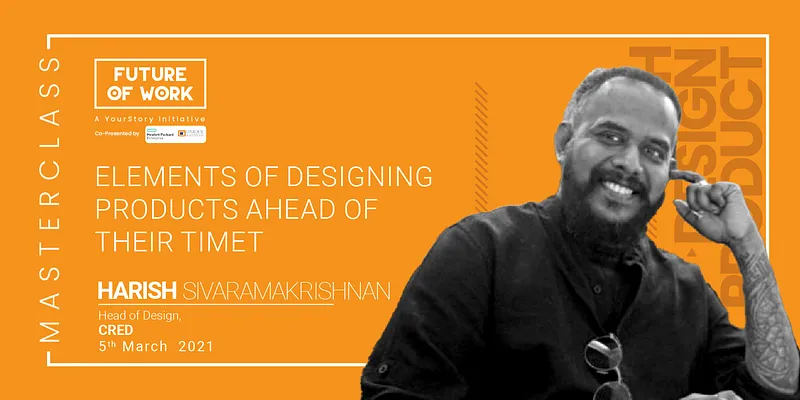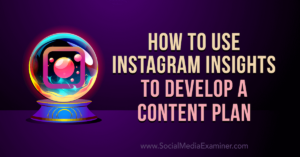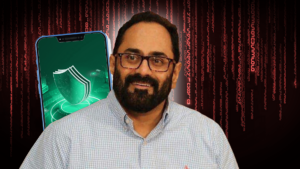“All users are not your customers. The users will download the app, and the customers will engage with the app. You do not design for all users. It has to work well for the targeted cohort of people,” said Harish Sivaramakrishnan, Head of Design at CRED, in a masterclass at the fourth edition of YourStory’s Future of Work 2021 summit.
Sharing his own guiding principles while busting a few myths on Day 1 of the summit, Harish — best known as the ”rockstar techie” — spoke about the elements for designing products ahead of their time.
The frontman for the Carnatic progressive rock band Agam, Harish has worked with Adobe, Myntra, Freecharge, and Google, before joining fintech startup CRED.
Here are some key takeaways from the masterclass:

The feature is not a product, the product is not a business
In his work career that spans 20 years, Harish has seen people who often confuse a product’s feature with the product itself.
“There is always a dominant feature of a product that we all know, and through the time, we start looking at that feature as the core purpose of the product, and sometimes, it even goes to one level further down, where the product itself gets confused for the overall business,” he said.
He reminds himself of these two things before he gets started with any design conversation.
He said the product itself does not constitute the business, or a feature of the product does not constitute the overall product.
“It’s important for us to know that whenever we design solutions, it’s about making you or whoever the person is, feel part of a journey and not as part of a transaction,” he added.
In Harish’s experience, any product that intrinsically tries to connect with the customer in a transactional fashion will get very easily replaced by another product. He said, making the user feel part of the journey is really important.
Sense of belonging in a smaller universe
Building a sense of belonging is one of the key metrics in designing products that actually last, he said. Interestingly, as per Harish, all users are not customers.
He explained, “You have users, and you have a large pool. A large universe of humans are potentially people who would download your app or your website, and customers are the ones that will end up adopting your product and start using it. While all users are potential customers, you don’t build a solution for all users.”
The idea is to get a product or a design work for a lot of people, but getting it to work incredibly well for a smaller, well-defined set of people, and eventually, making it work for a larger population.

Make it simple? No
However, Harish believes that simplicity is not a solution for everything. He pointed out that ‘making it simple’ is the most abused phrase in the world of designers, and he begs to differ.
“While I appreciate the spirit of that statement, it’s a very dangerous position to take in solving problems because not all simple solutions are great solutions. Sometimes you require the right degree of nuance, and sometimes the right degree of complexity to arrive at a solution, which will last,” he said.
Harish added that simplicity is a very important aspect of good design, but it is not the only thing. Sometimes, optimising and pivoting everything around simplicity may not be the right thing too.
Beauty or ugly
Speaking about another overused term in the world of product design, Harish quashed the fact that beauty is subjective.
“Yes, beauty is subjective, but that’s a terrible reason to not make things beautiful,” he said.
Harish simplified, saying subjective things are harder to measure and arrive at a consensus, but none of it is a good enough reason for product designers to not design a beautiful product.
“Beauty may not be about just the cosmetics, the visuals, it may not be about the colours even, but a good design cannot be ugly, and it is just not possible,” he said.
According to him, product design is a complex process, which involves research, flow, visual design, motion design, graphic design, and copywriting, among others, all of which contributes to the function of the form and the function of the product.
Every good product designer should have a great UX focus and great customer empathy. “However, the problem begins when we start using our UX focus and customer empathy as an excuse for lack of taste,” he said.
“Having a good UX focus, customer empathy, and a great taste, in my opinion, are non-negotiable for any product designer to build products that last,” he said.
Harish added quantitative data and research are other key elements to design a product ahead of its time. He insisted on research and understanding customer’s problems, but he urged not to over depend on the research.
It’s okay to make mistakes
“Just ensure that it is a new one every single time you make new mistakes. Don’t make the same mistake twice because that only shows you are not measuring enough,” said Harish.
He added that if you are deriving data and sources from your measurement, you are unlikely to make the same mistake twice. He said it is completely alright to make new mistakes as they are a great source of fast learning.
“A good design is always functional, efficient, and beautiful, and all the three together,” he concluded.
SPONSOR SHOUTOUT: A big shout-out to our Future of Work 2021 Co-presenting Sponsors Hewlett Packard Enterprise and Unique Solutions; Digital Excellence Partner Google Cloud; Associate Sponsors HP and Intel; and Sponsors Atlassian, Freight Tiger, Archon I Cohesity, TeamViewer, and Pocket Aces.











![Read more about the article [The Turning Point] How pivoting from a SaaS to marketplace model worked for B2B unicorn Zetwerk](https://blog.digitalsevaa.com/wp-content/uploads/2021/09/Zetwerk-1630653519416-300x150.png)